Scottish Health Survey – telephone survey – August/September 2020: main report
Presents results for the Scottish Health Survey – telephone survey- August to September 2020, providing information on the health and factors relating to health of people living in Scotland.
This document is part of a collection
Chapter 7: Smoking
This summary covers data collected between the 5th August 2020 and the 23rd September 2020.
Around one in ten adults identified as a current smoker, with the majority reporting that they had never smoked.
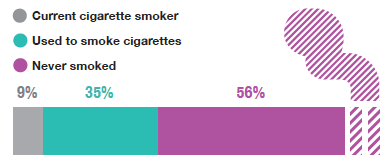
Smoking prevalence was higher among men than women.
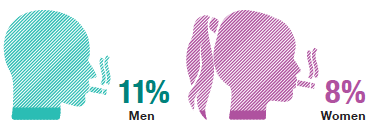
Men* also reported smoking a higher mean number of cigarettes per day than women*.
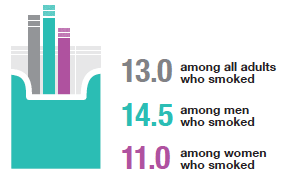
The prevalence of non-smokers that reported being exposed to second-hand smoke** decreased by age.
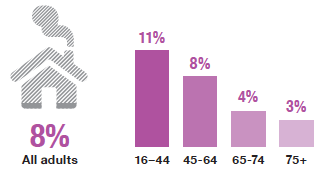
Around 1 in 20 adults were current e-cigarette users.
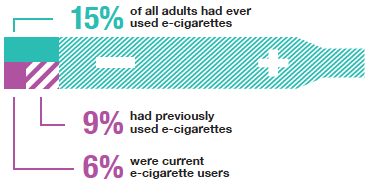
Men and young adults were more likely to report having ever used an e-cigarette.
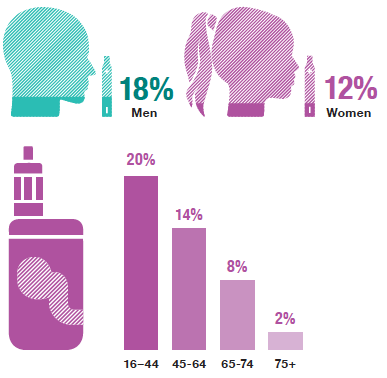
A significant proportion of people reported an increase in the amount that they smoked since the beginning of lockdown***.
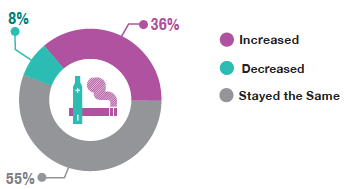
* Among those who identified as a current smoker.
** In own home, other people’s homes, in cars/vans, outside buildings, at work, or in other public places.
*** Lockdown began on 23rd March 2020.
7 Smoking
Claire Elliott
7.1 Introduction
The World Health Organisation describe tobacco as ‘one of the biggest public health threats the world has ever faced’[1]. In Scotland, smoking was associated with around 100,000 hospital admissions in 2018, with a smoking-attributable disease or condition the primary reason for more than half of these[2]. As the cause of around one in five deaths and the primary preventable cause of premature death, smoking represents the chief threat to Scotland’s public health[3]. While overall smoking rates have declined in Scotland, differences by deprivation have increased, with rates highest in the most deprived areas, highlighting that smoking remains an ongoing health inequality challenge[4].
Protecting Scotland, Renewing Scotland: The Government’s Programme for Scotland 2020-21[5] reaffirms the government’s commitment to the action plan outlined in Raising Scotland’s Tobacco-free Generation published in June 2018[6]. The action plan outlines interventions and policies that aim to ensure Scotland is raising a tobacco-free generation by 2034 (defined as ‘a smoking prevalence among the adult population of 5% or lower’).
There is a potential for COVID-19 to impact on smoking rates. For example, those with mental health problems such as anxiety or depression are more likely to smoke than the general population[7] and evidence suggests that COVID-19 has led to increased stress and mental health problems in the general population[8]. Also, recent evidence suggests that smoking is associated with increased severity of disease and death in hospitalized COVID-19 patients[9]. At the time of data collection, initially up to 8 people from three households and from the 14th of September and onwards up to 6 people from two households could meet indoors, including in other people’s homes. These restrictions could have impacted on rates of exposure to second-hand smoke within other people’s homes[10,11]. Finally, due to COVID-19, in-person access to GP services in Scotland for support with smoking cessation was variable and limited, but for anyone wishing to quit, services were available online and pharmacists were able to deliver prescriptions[12].
This chapter presents findings on the prevalence of cigarette smoking and e-cigarette use in the Scottish adult population in August/September 2020 as well as self-reported changes to smoking habits since lockdown began and non-smokers’ exposure to second-hand smoke. Information on methods and definitions can be found in Volume 2: Technical Report.
7.2 Smoking
The fieldwork period referenced in the following analysis covers from the 5th August 2020 to the 23rd September 2020.
In interpreting these results, note that, in the usual format of the Scottish Health Survey, younger adults are asked about smoking within a self-completion form rather than the interviewer asking the questions. The self-completion format enables younger adults aged 16-19, particularly those living within the family home, to answer these questions privately. For this reason and as levels of smoking and e-cigarette use tend to be much higher in deprived areas where response to this survey was lower than usual, the following results may underestimate true prevalence.
7.2.1 Cigarette smoking status, August/September 2020, by age and sex
During the fieldwork period, 9% of adults identified as current smokers, with smoking prevalence higher among men (11%) than women (8%). There were also differences in overall smoking prevalence by age with the highest prevalence of current smoking among those aged 45-64 (12%) and the lowest among those aged 75 and over (3%).
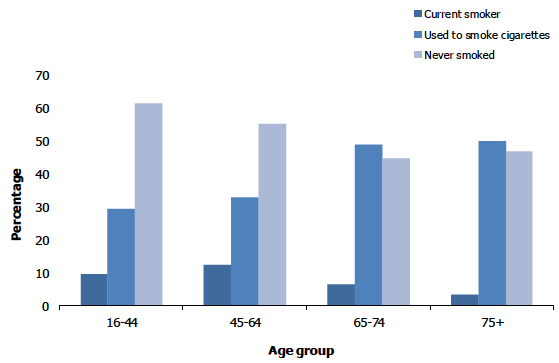
On average, among all adults, current smokers smoked 13.0 cigarettes per day; this was higher among male smokers than female smokers (14.5 and 11.0 respectively). There were no significant differences in the mean number of cigarettes smoked by age.
Just over a third of adults (35%) reported that they had smoked cigarettes previously but did not smoke nowadays. Older adults were more likely than younger adults to report that they had previously smoked cigarettes (49% - 50% of those aged 65 and over compared with 29% of those aged 16-44). Men were also more likely than women to report having previously smoked (38% compared with 32%), particularly men aged 75 and over compared with women in the same age group (67% and 38% respectively).
More than half of adults reported that they had never smoked (56%) with the highest proportion among those aged 16-44 (61%) and the lowest among those aged 75 and over (47%). Women were more likely than men to report that they had never smoked (60% compared with 51%), with a 30 percentage point gap recorded between the proportion of women aged 75 and over and men in the same age group who reported that they had never smoked (59% and 29% respectively).
Figure 7A, Table 7.1
7.2.2 Non-smokers’ exposure to second-hand smoke, August/September 2020, by age and sex
During fieldwork, just under one in ten adult non-smokers (8%) reported being exposed to second-hand smoke across a range of settings[13] with the highest proportions reported for second-hand smoke exposure either in their own or someone else’s home (4%), followed by ‘other people’s homes’ specifically and ‘in any public space’ (both 3%).
Few significant variations by age or sex were recorded during the fieldwork period with the exceptions of a higher proportion of younger non-smokers reporting exposure to second-hand smoke in any public space (5% of those aged 16-44 compared with 1% of those aged 75 and over) including outside buildings such as pubs, shops and hospitals (4% of those aged 16-44 compared with 1% of those aged 75 and over) and male non-smokers reporting that they were exposed to second-hand smoke at work (2% compared with <1% of female non-smokers).
The likelihood of non-smokers being exposed to second-hand smoke reduced with age from 11% of non-smokers aged 16-44 to 3% of non-smokers aged 75 and over. Similar patterns by age were found for men and women.
Table 7.2
7.2.3 E-cigarette use, August/September 2020, by age and sex
During the fieldwork period, 15% of adults reported ever having used e-cigarettes, with 6% of all adults self-reporting as current e-cigarette users and 9% reporting that they had previously used them.
Among current e-cigarette users there was no significant difference by sex, however men were more likely than women to have reported previously using e-cigarettes (11% compared with 7%) and women were more likely than men to report never having used e-cigarettes (88% and 82% respectively).
The highest proportion of current e-cigarette users was recorded among those aged 16-44 (8%) with the lowest among adults aged 75 and over (<1%). Similar patterns were found for men and women.
Younger adults were more likely than older adults to have previously used e-cigarettes (12% of those aged 16-44 compared with 2% of adults aged 75 and over) with similar patterns for men and women. Adults aged 75 and over were most likely to report that they had never used e-cigarettes (98% compared to 80% of those aged 16-44).
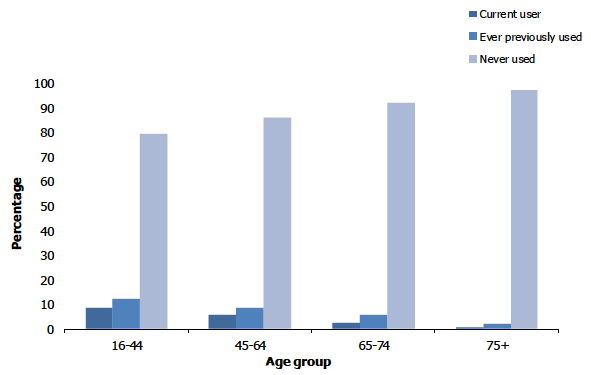
Figure 7B, Table 7.3
7.2.4 Self-reported changes to smoking habits since lockdown began (23rd March), August/September 2020, by age and sex
During the fieldwork period, over half (55%) of adult smokers self-reported that the amount they smoked had stayed the same since the beginning of lockdown (23rd March 2020). Just over a third (36%) reported that there had been an increase in the amount they smoked and fewer (8%) reported a decrease.
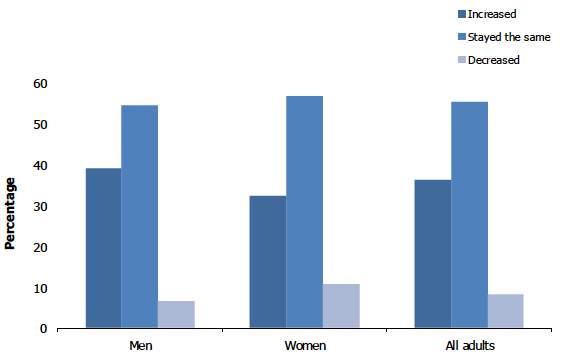
There were no statistically significant differences found in changes to the amount adults smokers smoked since lockdown began by age or sex.
Figure 7C, Table 7.4
Table List
Table 7.1 Cigarette smoking status, August/September 2020, by age and sex
Table 7.2 Non-smokers’ exposure to second-hand smoke, August/September 2020, by age and sex
Table 7.3 E-cigarette use, August/September 2020, by age and sex
Table 7.4 Self-reported changes to smoking habits since lockdown began (23rd March), August/September 2020, by age and sex
The tables can be found in the main report page under supporting documents.
References and notes
1. World Health Organisation (2019) Tobacco.
2. See: Scotpho Tobacco use: smoking attributable admissions
3. Raising Scotland’s tobacco-free generation: our tobacco control action plan 2018. Edinburgh: Scottish Government, 2018.
4. Vosnaki, K, (2019). Chapter 5: Smoking. In: McLean, J and Wilson, V. (eds.) The Scottish Health Survey 2019 – Volume 1: Main Report. Edinburgh: Scottish Government. 2020.
5. Protecting Scotland, Renewing Scotland: The Government's Programme for Scotland 2020-2021, p. 72 [Online].
6. Raising Scotland’s tobacco-free generation: our tobacco control action plan 2018. Edinburgh: Scottish Government, 2018.
7. See: NHS: Stopping smoking for your mental health
8. Salari, N., Hosseinian-Far, A., Jalali, R. et al. Prevalence of stress, anxiety, depression among the general population during the COVID-19 pandemic: a systematic review and meta-analysis. Global Health, 16, 57 (2020).
9. See: WHO: Smoking and COVID-19
10. See: Coronavirus (COVID-19) Phase 3: Scotland's route map update - 9 July 2020 - gov.scot
11. See: Coronavirus (COVID-19) update: First Minister's speech 14 September 2020 - gov.scot
12. See: NHSInform: Coronavirus (COVID-19): Stopping smoking
13. These places defined as: in own home, other people’s homes, in cars/vans, outside buildings, at work, or in other public places.
Contact
There is a problem
Thanks for your feedback